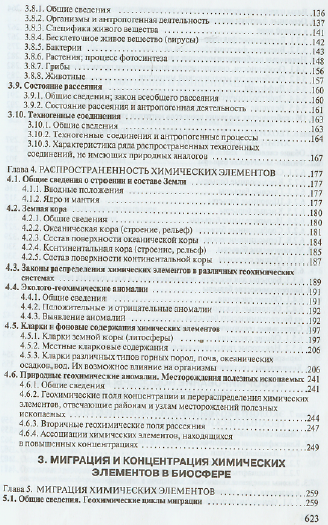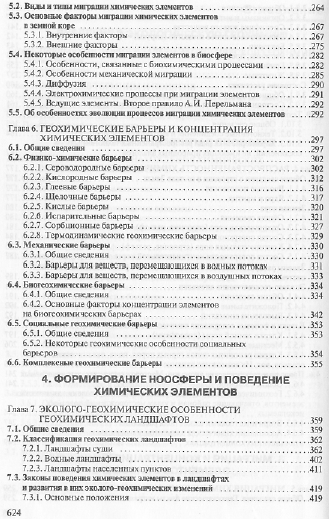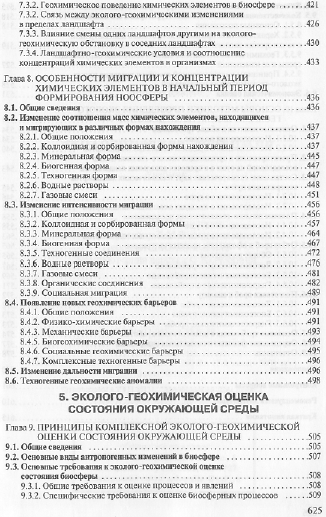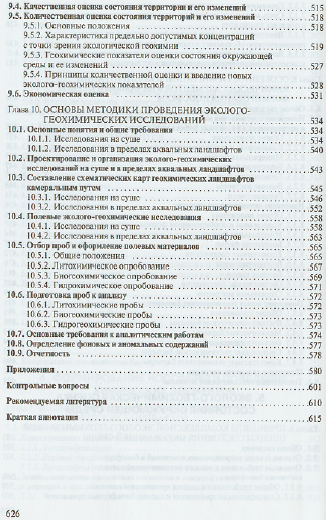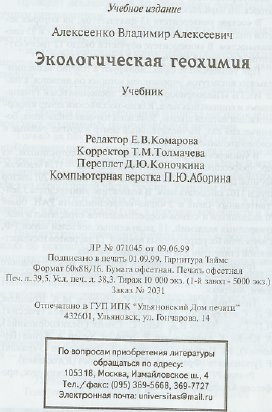
- •И зменение фонового содержания, п • 10-3 % по массе, ряда металлов в почвах сопряженных сельскохозяйственных ландшафтов, подверженных воздушной эрозии
- •Третий классификационный уровень
- •Четвертый классификационный уровень
- •Пятый классификационный уровень
- •Шестой классификационный уровень
- •Седьмой классификационный уровень
- •Восьмой классификационный уровень
- •7.2.2. Водные ландшафты
- •Первый классификационный уровень
- •Второй классификационный уровень
- •Третий классификационный уровень
- •С реднее содержание элементов в донных отложениях ландшафтов третьего классификационного уровня реки Дон
- •Среднее содержание элементов в золе тростника ландшафтов третьего классификационного уровня реки Дон
- •Четвертый классификационный уровень
- •Среднее содержание элементов в илах ландшафтов пятого классификационного уровня реки Дон
- •Шестой классификационный уровень
- •7.2.3. Ландшафты населенных пунктов
- •7.З. Законы поведения химических элементов в ландшафтах и развития в них эколого-геохимических изменений
- •7.3.1. Основные положения
- •7.3.2. Геохимическое поведение химических элементов в биосфере
- •7.3.2. Связь между эколого-геохимическими изменениями в пределах ландшафта
- •7.3.3. Влияние смены одних ландшафтов другими на эколого-геохимическую обстановку в соседних ландшафтах
- •7.3.4. Ландшафтно-геохимические условия и соотношение концентраций химических элементов в организмах
- •Глава 8. Особенности миграции и концентрации химических элементов в начальный период формирования ноосферы
- •8.1. Общие сведения
- •8.2. Изменение соотношения масс химических элементов, находящихся и мигрирующих в различных формах нахождения
- •8.2.1. Общие положения
- •8.2.2. Коллоидная и сорбированная формы нахождения
- •Допустимые величины выбросов пыли в атмосферу промышленными предприятиями (по документам сша, Германии, Франции, Швеции)
- •Содержание цинка в городских почвах
- •8.2.3. Минеральная форма
- •8.2.4. Биогенная форма
- •8.2.5. Техногенная форма
- •8.2.6. Водные растворы
- •8.2.7. Газовые смеси
- •8.3. Изменение интенсивности миграции
- •8.3.1. Общие положения
- •8.3.2. Коллоидная и сорбированная формы
- •8.3.3. Минеральная форма
- •6) То же, по реке с хорошо выраженными механическими природными барьерами; в) миграция от рудников, карьеров и обогатительных фабрик;
- •8.3.4. Биогенная форма
- •8.3.5. Техногенные соединения
- •8.3.6. Водные растворы
- •Интенсивность миграции элементов в подземных водах зоны гипергенеза
- •8.3.7. Газовые смеси
- •8.3.8. Органические соединения
- •Химический состав газов в газовых и газонефтяных залежах
- •8.3.9. Социальная миграция
- •5.4. Появление новых геохимических барьеров
- •8.4.1. Общие положения
- •8.4.2. Физико-химические барьеры
- •8.4.3. Механические барьеры
- •8.4.5. Биогеохимические барьеры
- •8.4.6. Социальные геохимические барьеры
- •8.4.7. Комплексные техногенные барьеры
- •8.5. Изменение дальности миграции
- •8.6. Техногенные геохимические аномалии
- •Глава 9. Принципы комплексной эколого-геохимической оценки состояния окружающей среды
- •9.1. Общие сведения
- •9.2. Основные виды антропогенных изменений в биосфере
- •9.3. Основные требования к эколого-геохимической оценке состояния биосферы
- •9.3.1. Общие требования к оценке процессов и явлении
- •9.3.2. Специфические требования к оценке биосферных процессов
- •9.4. Качественная оценка состояния территории и его изменений
- •9.5. Количественная оценка состояния территорий и его изменений
- •9.5.1. Основные положения
- •9.5.2. Характеристика предельно допустимых концентраций с точки зрения экологической геохимии
- •9.5.3. Геохимические показатели оценки состояния окружающей среды и ее изменений
- •9.5.4. Принципы количественной оценки и введение новых эколого-геохимических показателей
- •9.6. Экономическая оценка
- •10.1. Основные понятия и общие требования
- •10.1.1. Исследования на суше
- •10.1.2. Исследования в пределах аквальных ландшафтов
- •§ 34. Основными задачами, стоящими перед региональными работами, являются:
- •10.2. Проектирование и организация эколого-геохимических исследований на суше и в пределах аквальных ландшафтов
- •10.3. Составление схематических карт геохимических ландшафтов камеральным путем
- •10.3.1. Исследования на суше
- •§ 58. На карту 2 в соответствии с требованиями второго классификационного уровня выносятся биогенные ландшафты. Деталь
- •10.3.2. Исследования в пределах аквальных ландшафтов
- •§ 73. На карте 5 ландшафты разделяются в зависимости от из-нения геоморфологических особенностей, влияющих на меха-кческую миграцию элементов в водных ландшафтах.
- •§ 74. На карте 6 ландшафты разделяются в зависимости от типа донных отложений.
- •10.4. Полевые эколого-геохимические исследования
- •10.4.1. Исследования на суше
- •§ 80. На стадии режимных наблюдений при работах, связанных ественной оценкой состояния окружающей среды, произво-
- •§ 85. Полевые работы по проведению второй части рассматриваемых этапов (см. § 81 – 83) могут начинаться только после завершения работ первой части и выделения аномалий. Допустимо
- •10.4.2. Исследования в пределах аквальных ландшафтов
- •10.5. Отбор проб и оформление полевых материалов
- •10.5.1. Общие положения
- •10.5.2. Литохимическое опробование
- •10.5.3. Биогеохимическое опробование
- •10.5.4. Гидрохимическое опробование
- •10.6. Подготовка проб к аналізу
- •10.6.1. Литохимические пробы
- •10.6.2. Биогеохимические пробы
- •10.6.3. Гидрогеохимические пробы
- •10.7. Основные требования к аналитическим работам
- •10.8. Определение фоновых и аномальных содержаний
- •10.9. Отчетность
- •Гидрогеологическая характеристика
- •Геологическая характеристика
- •Описание растительности
- •Описание лугов
- •Глава 1
- •Глава 2
- •Глава 3
- •Глава 4
- •Глава 5
- •Глава 6
- •Глава 7
- •Глава 8
- •Глава 9
- •Глава 10
- •К главе 1
- •К главе 2
- •К главе 3
- •К главе 4
- •К главе 5
- •К главе 6
- •К главе 7
- •К главе 8
- •К главе 9
- •К главе 10
- •Глава 1. Предмет, история и задачи экологической геохимии
- •Глава 2. Основные термины и понятия
- •Глава 3. Основные формы нахождения химических элементов в земной коре
- •Глава 4. Распространенность химических элементов
- •Глава 5. Миграция химических элементов
- •Глава 6. Геохимические барьеры и концентрация химических элементов
- •Глава 7. Эколого-геохимические особенности геохимических ландшафтов
- •Глава 8. Особенности миграции и концентрации химических элементов в начальный период формирования ноосферы
- •Глава 9. Принципы комплексной эколого-геохимической оценки состояния окружающей среды
- •Глава 10. Основы методики проведения эколого-геохимических исследований
Глава 10. Основы методики проведения эколого-геохимических исследований
В заключительной главе рассматривается методика эколого-геохимических исследований, проводимых на ландшафтно-геохимической основе. Разбираются общие требования к исследованиям, проводимым на суше и в пределах аквальных ландшафтов; требования к проектированию работ, составлению картографированных материалов. Отдельно рассматриваются отбор проб, оформление полевых материалов, подготовка проб к анализу и требования к аналитическим работам.
Summary
Chapter 1. Subject, history and tasks of the ecological geochemistry
General information is given on the new science that was bom on the boundary between general geochemistry, geology, ecology, landscape geochemistry, soil science, biogeochemistry. The history of formation of the science is concisely considered. There is showed a most important contribution to the formation of ecogeochemistry of such prominent scientists as V.I. Vemadskiy, F.V. dark, V.M. Goldschmidt, B.B. Polynov, V.V. Dokuchaev, A.I. Perelman, V.V. Dobrovolskiy and others.
Chapter 2. Main terms and definitions
A number of terms and concepts are concisely dealt with, used in the manual. Knowing of them is necessary for studying of ecological geochemistry. All of them are divided into four main sections: 1. Geological, physical and chemical, and geochemical proper terms and definitions; 2. Ecobiological definitions;
3. Concepts of geochemical landscapes and geochemical barriers; 4. The ones of the noosphere and technogenesis. This make possible for the potential readers of the book to begin an acquaintance of ecogeochemistry without deep studying of geology, biology, ecology, geochemistry, landscape geochemistry.
Chapter 3. The main forms of state of chemical elements in the Earth's crust
A definition of the forms of state of chemical elements is given that is understood as systems of different relatively stable chemical equilibriums of these elements. The most significant in the biosphere 9 forms of state of chemical elements are dealt with: minerals, isomorphic, water solutions, gas mixtures, colloidal and sorption forms, magmatic, biogenic, state of dispersion, technogenic ones. For the first time for the biosphere colloidal and sorption forms and technogenic compounds has been considered. The information on the distribution of forms of state in the biosphere in their connection with main anthropogenic processes and that on the stability in alternating conditions of the biosphere are given.
Chapter 4. Dispersion of chemical elements
The information on the composition of continental and oceanic crust is
given. General trends in chemical elements distribution in the Earth's crust on the whole and in different kinds of its constituent rocks. For the first time there has been considered the influence exerted on organisms in their habitat by both
619
absolute values of chemical elements concentrations and dispersion of their dark concentrations in different geochemical systems. Definitions of parameters of absolute and relative dispersions of chemical elements are given. Data are presented concerning the laws of chemical elements distribution in geochemical systems, geochemical anomalies of a different scales and methods for their determining;
absolute and relative dispersion of darks, coefficients of biological uptake, excessive and deficient for organisms elements, natural associations of chemical elements at higher concentrations, located in different geochemical systems.
Chapter 5. Migration of chemical elements
The information on the energy sources by means of which migration of chemical elements takes place in the biosphere is presented. Geochemical cycles, three main types and four kinds of migration of chemical elements within the habitat of living organisms are dealt with. Agents of migration both inner derived from properties of atoms and their compounds and outer brought about by conditions in which migration takes place are widely considered. Special attention is paid to zonal depositions of elements, migrating in solutions, to influence of radioactive decay and different biogeochemical processes on migration. Progressive evolution of migration processes in the Earth's history is considered.
Chapter 6. Geochemical barriers and concentration of chemical elements
There considered a fundamental concept, introduced into natural sciences by academician A. I. Perelmanin 1961 — geochemical barriers. Geochemical barriers are classified. For main classes such as physical and chemical, biogeochemical, mechanical and social barriers are dealt with in the charter. Peculiarities of chemical elements and their compounds' concentration on different kinds of barriers are considered. Geochemical barriers are characterized in a way that enables to make a quantitative assessment of each one. There is demonstrated a possibility of forecasting of concentrations of some chemical elements and compounds on certain geochemical anomalies.
Chapter 7. Geochemical landscapes
For the first time in the manual the classification of geochemical landscapes developed and tested by the author is given. Main geochemical peculiarities of natural and technogenic landscapes are investigated, a special attention being paid to processes of migration and concentration of these. Geochemical peculiarities of terrestrial (agricultural, industrial, urban, lumbering, road) and aqual landscapes, artificial water bodies included, are considered.
Special attention is paid to the landscapes of populated areas, dwelling upon the principles of their classification.
620
The laws, describing a behavior of chemical elements within landscapes and development of ecogeochemical changes both within a landscape and within groups of adjoining landscapes are considered.
Chapter 8. Peculiarities of migration and concentration of chemical elements at the first period of the noosphere formation
Migration and concentration of chemical element during the period in question are taking place under influence of natural and anthropogenic agents, with a contribution of the formers gradually increasing. Parameters determining peculiarities of migration of elements are described. In the author's opinion they are as follows:
mass ratio of chemical elements, presenting and migrating in the biosphere in different forms;
migration intensivity;
new geochemical barriers formation;
distance ofmigration-
In the special section of the chapter peculiarities of technogenic geochemical anomalies are dealt with. The law of composition of the associations of chemical elements, forming large technogenic anomalies and consequences, arising out of this law are considered.
Chapter 9. Principles of the integrated ecogeochemical assessment of the environmental status
General and special requirements to assessment of the processes and phenomena taking place in the biosphere are given in the chapter. Peculiarities of qualitative and quantitative ecogeochemical assessment of area's status and its alteration are considered in details. From the ecogeochemical point of view some normalizing indices are characterized. Possibility and necessity of using new ecogeochemical indices are considered. The possibility of making economic assessment of the areas and ecological changes, taking place within these areas are concisely considered.
Chapter 10. Main principles of the technique for ecogeochemical investigations
In the chapter the technique for ecogeochemical investigations, carried out on the landscape geochemical basis is considered. General requirements to investigations, concerning planning field works, cartographical materials, sampling, preparing samples to analysis and others are considered.
621

